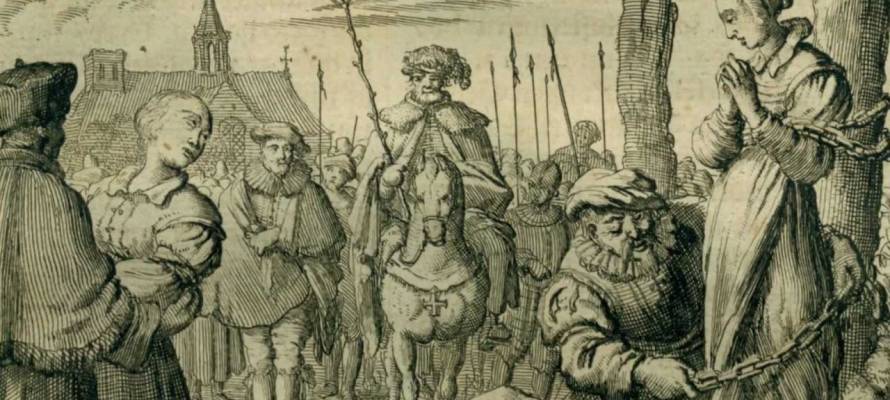Throughout our long history, Jews have overcome all sorts of obstacles to observe the mitzvah of sukkah. But perhaps one of the most striking instances is the sukkah built in Mexico City in the year 1603 by a crypto-Jew named Sebastian Rodriguez.
By Libi Astaire, Aish.com
Sebastian Rodriguez, a crypto-Jew, was arrested by the Inquisition for committing the crime of Judaizing – practicing Judaism in secret – and was sitting in jail. With the festival of Sukkot fast approaching, he decided to do the impossible: Build a sukkah. In prison. Under the eyes of his jailers, agents of the Spanish Inquisition.
There was only one question: How on earth was he going to do it?
A Precarious World
The fragile, temporary sukkah (hut) is supposed to remind us that life is transient. Our homes, our jobs, even our entire way of life, can be uprooted in the blink of an eye. The Jews of Spain learned that difficult lesson in the year 1391, when angry peasant mobs went on a rampage. By the time the rebellion was stopped, almost every Jewish community in Spain had been destroyed. Thousands of Jews were killed, and tens of thousands were forcibly baptized.
Many of these “New Christians,” who are also known as crypto-Jews or Anusim (the forced ones), only pretended to be good Christians. In their hearts, they still considered themselves to be Jews, and behind closed doors they continued to secretly practice their Jewish religion.
In some places, at least in the early years of the 15th century, their allegiance could be displayed more openly. Some crypto-Jews continued to go to family celebrations, and they even celebrated the Jewish holidays with their still-Jewish family and friends.
They also could see firsthand what the Church was doing to harass and oppress Spain’s dwindling Jewish population, since the Church hoped that poverty and degradation would convince these remaining Jews to abandon their faith. Therefore, many Anusim – who were able to keep their jobs and their wealth because they were Christians, even if in name only – tried to help. Before Sukkot, for example, some Anusim women would lend out their expensive fabrics and rugs to decorate the sukkahs in the Jewish ghetto. They would even lend their fine dresses and jewels to impoverished Jewish women.
During the holiday, Anusim would visit the sukkahs, and it certainly helped that medieval cities were very small. Should anyone question them, the Anusim would reply that they just happened to be passing by and were curious to see the little booths. Once they were inside, they accepted the offer to have some refreshments. But the visit had nothing to do with the Jewish commandment to dwell in the sukkah – or so the Anusim said to outsiders.
Those Anusim who wished to build their own sukkah would usually go out to a nearby field and build it there. If they were questioned, they again had a ready answer: They put up the booths because they heard that bad weather was coming.
This open contact between the two communities continued until 1478, when a new blow befell the Anusim: the Spanish Inquisition. Almost overnight, it became a punishable crime to have anything to do with the Jewish religion, and those pleasant memories of sitting in the sukkah came back to haunt them.
In the Inquisition’s records we can read the testimony of Elvira Martiez of Toledo, who in 1509 tried to convince her interrogators that her visit to a sukkah was “not on account of the ceremony but rather in order to see the said booth.” Juana Rodriguez was more defiant. Arrested in 1504, she said that she remembered lending a rug and a bordered sheet to a Jew, so he could make his sukkah, “all of which I did in honor of, and in keeping with the law of the Jews, thinking that I would be saved by it.”
But whether they responded with fear or defiance, the Anusim knew that the noose was tightening – for all of them.
A New World
Already in despair, things seemed to go from bad to worse in 1492, when the Jews were expelled from Spain and the Anusim community’s last tangible connection to Jewish life was severed. Then came the news that Christopher Columbus had discovered a “new world,” and that gave the Anusim renewed hope. Once the Spanish decided to colonize Nueva Espagna (present-day Mexico), they needed people to settle the new colony. The Anusim, who were eager to escape from the Inquisition, left Spain en masse. According to many estimates, by the middle of the 1500s there were more crypto-Jews living in Mexico City than Spanish Catholics.
Worried Catholic officials in Mexico wrote letters to the Spanish government to complain. The government responded in two ways: enacting the Blood Purity Law, which limited immigration to Mexico to only those New Christians who could prove that their families had been New Christians for at least the last three generations, and the establishment of the Mexican Inquisition, an arm of the Inquisition in Spain.
Interestingly, the Mexican Inquisition didn’t target the native Indians, even though there were many who continued to observe their pagan practices after their conversion. Instead, it concentrated on ferreting out heretics from among the European and mulatto populations. Protestants and Catholics accused of moral lapses figure prominently in the records. Crypto-Jews were another prominent group among the accused.
Yet despite the threat of discovery and possible death, the Anusim continued to practice Judaism to the best of their ability. Since they didn’t have access to a Jewish calendar, many communities calculated the dates of holidays according to the lunar cycle. Sukkot was therefore celebrated 14 or 15 days after the new moon of September was spotted. Over the years, the four species were forgotten, but the memory of the sukkah lived on. Some Anusim would continue to go out to the fields to build their booths, while others would find some other way to observe the mitzvah in secret.
A Hopeful World
The worst years of the Mexican Inquisition occurred early on. For instance, at the auto-da-fe that took place in Mexico City in December 1596, out of the 66 prisoners sentenced, 41 had been accused of Judaizing. Of these, 22 were reconciled to the Church, 10 were burned in effigy, since they had escaped from Mexico, and nine crypto-Jews were burned at the stake.
It’s very possible that the Sebastian Rodriguez of our sukkah story was among the crypto-Jews who were sentenced that December. The records tell us that a Sebastian Rodriguez and his wife Constanza were among “Those to be reconciled for guarding and observing the dead Law of Moses,” as were other members of his extended family, whose names also appear in the prison account.
The term “reconcile” sounds better than it was, which is perhaps why a popular expression of the time somewhat cynically stated “One can leave the Inquisition without being burned, but he will assuredly leave scorched.” To be reconciled to the Church meant that the Church was willing to let you live – as a Christian – but you were still going to be punished. In the case of Constanza and Sebastian Rodriguez, their punishment was “perpetual imprisonment” and the confiscation of all their goods.
What they did on Sukkot for the first six years of their imprisonment isn’t known, but there is a memorable record of what happened the seventh year, which appears in David Martin Gitlitz’s book Secrecy and Deceit: The Religion of the Crypto-Jews (University of New Mexico Press).
One evening during the holiday, Sebastian Rodriguez asked a man named Captain Lemos (who turned out to be an informer) to go and get a lot of branches. When Lemos returned, he was accompanied by four Indians, all of whom had been enlisted to bring willow branches to the prison. After a few of the prison’s corridors and an interior courtyard that was open to the sky were decorated with the branches, tables were set up in the corridors. Another table was placed in front of the room overlooking the courtyard where Rodriguez, his wife, and other family members and friends were imprisoned. Then, when all was ready, food was brought to the prison and served by family members who were still free.
This last bit wasn’t unusual, since families were expected to take care of their imprisoned relatives, which included bringing them their meals. What was unusual, though, was the festiveness of the occasion. Granted, the Rodriguez sukkah probably wasn’t 100 percent kosher. But according to Lemos, the happiness of Yom Tov was definitely there. Not only was there a lavish meal, but also music and singing and much rejoicing.
How did Rodriguez get away with it? He told the prison warden – who attended the meal as a guest, along with his wife – that this was a wedding celebration!
Was the warden really fooled? Was he bribed? Was he also a crypto-Jew, or someone with relatives who were crypto-Jews? We don’t know.
But we do know that, some 400 years later, Rodriguez’s decision to build a sukkah is still an inspiring example of the Jewish people’s determination to keep the Torah wherever we are – even if that’s under the nose of the Spanish Inquisition.
Sources:
Heretics or Daughters of Israel?: The Crypto-Jewish Women of Castile, Professor Renee Levine Melammed, Oxford Scholarship Online: October 2011.
Secrecy and Deceit: The Religion of the Crypto-Jews, David Martin Gitlitz, University of New Mexico Press, April 2002.
The Inquisition in New Spain, 1536–1820: A Documentary History, edited by John F. Chuchiak IV, Johns Hopkins University Press, April 2012.

Do You Love Israel? Make a Donation - Show Your Support!
Donate to vital charities that help protect Israeli citizens and inspire millions around the world to support Israel too!
Now more than ever, Israel needs your help to fight and win the war -- including on the battlefield of public opinion.
Antisemitism, anti-Israel bias and boycotts are out of control. Israel's enemies are inciting terror and violence against innocent Israelis and Jews around the world. Help us fight back!



